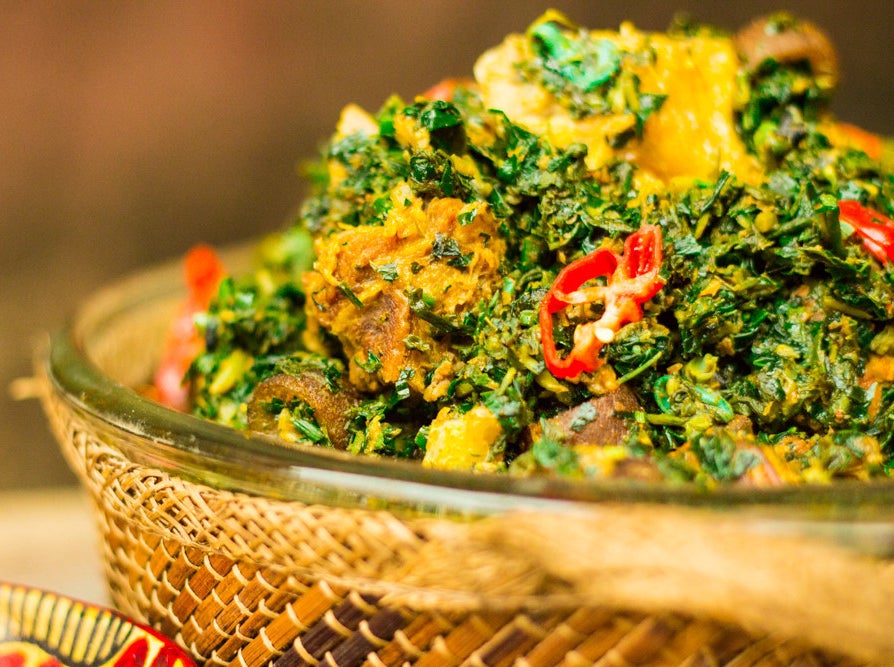
Nigeria is a land of rich culture and diverse culinary heritage, with its soups taking center stage as a true testament to the nation’s flavors. Among these, Afang Soup, Oha Soup, and Bitterleaf Soup are iconic dishes, each showcasing the uniqueness of its region and ingredients. Let’s dive into what makes these delicacies so special!
Afang Soup: A Rich Delight from the South-South
Afang Soup originates from the Efik and Ibibio tribes of Nigeria’s South-South region. Made with a blend of fresh waterleaf and shredded afang (wild spinach), this soup is both nutritious and delicious.
Key Ingredients:
- Afang leaves (wild spinach)
- Waterleaf
- Assorted meats (goat, beef, or chicken)
- Smoked fish and stockfish
- Periwinkles (optional but traditional)
- Palm oil and ground crayfish
Afang Soup is hearty and flavorful, with a distinct nutty taste from the afang leaves. It pairs beautifully with fufu, pounded yam, or eba, making it a staple at gatherings and celebrations.
Oha Soup: A Traditional Igbo Treasure
Oha Soup, also known as Ora Soup, is a beloved dish from Nigeria’s southeastern Igbo tribe. What sets this soup apart is the use of fresh, tender oha leaves, which are carefully plucked (not cut) to retain their natural flavor.
Key Ingredients:
- Oha leaves
- Cocoyam (used as a thickener)
- Palm oil
- Assorted meats and fish
- Ogiri (fermented locust bean paste for flavor)
Oha Soup is a creamy and aromatic dish that brings comfort with every spoonful. It’s often served with pounded yam, fufu, or wheat, and its unique taste is one you’ll crave over and over.
Bitterleaf Soup: A Bitter-Sweet Experience
Known as Ofe Onugbu in Igbo, Bitterleaf Soup is a classic delicacy cherished for its rich flavors. The bitterness of the leaves is skillfully washed away, leaving a unique taste that balances savory and earthy notes.
Key Ingredients:
- Bitterleaf
- Cocoyam paste (for thickening)
- Assorted meats and fish
- Stockfish and dried fish
- Palm oil and crayfish
- Ogiri (optional but traditional)
This soup’s depth of flavor comes from the combination of tender meats, dried fish, and the subtly sweetened bitterness of the leaves. Bitterleaf Soup is best enjoyed with pounded yam, amala, or semovita.
Why These Soups Are Must-Try Delicacies
- Nutritional Value: Packed with vitamins, minerals, and proteins, these soups are as healthy as they are tasty.
- Cultural Significance: Each soup represents the traditions and stories of the region it comes from.
- Versatility: Whether for a family dinner or a festive celebration, these soups always shine.
Conclusion
Nigeria’s culinary landscape is vast and exciting, with soups like Afang Soup, Oha Soup, and Bitterleaf Soup offering a taste of the nation’s rich heritage. Each spoonful tells a story, connects you to the land, and leaves you craving more.
Why not treat yourself to one of these delicacies today? At Amala360, we bring the best of Nigeria’s flavors straight to your table.
Moreover, the WordPress community and theme developers are actively contributing to a growing library of block patterns, making it easier for users to find a pattern that suits their needs. Whether you`re building a landing page, a photo gallery, or a complex layout, there`s likely a block pattern ready to use. This democratizes design for non-technical users while offering developers a way to extend WordPress functionality and provide more options to their clients.